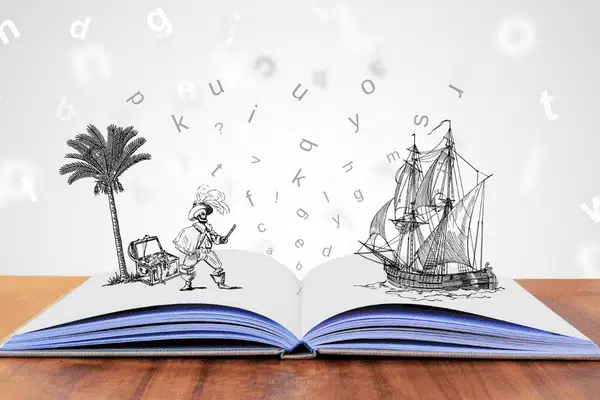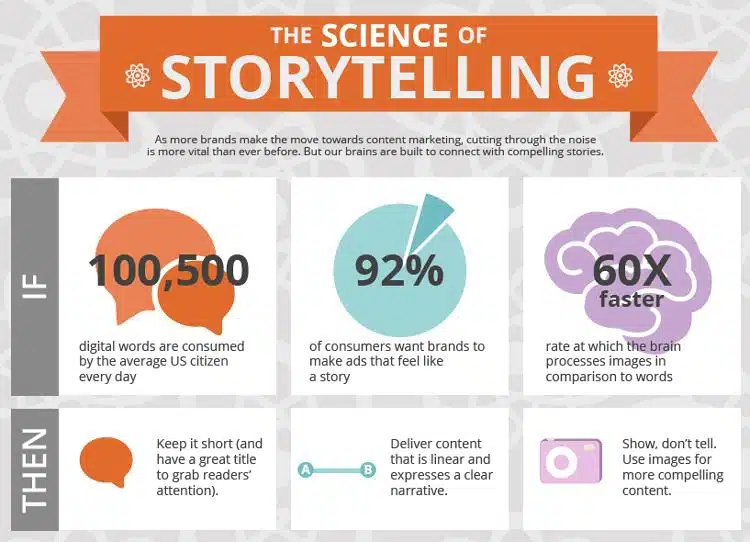From bedtime stories as children to commitments that shape our lives, storytelling is integral in passing experience and information.
Through narratives of triumphs, hardships, and common life events, we can better relate with each other, giving products or brands a chance to achieve significance within those personal plotlines.
It is when a brand, company, or product uses storytelling to connect with its audience and build relationships that it really makes an impact.
Stories give organizations real-life examples that are more powerful; they bring context and relatability to conversations.
This blog post will explore why storytelling works so well in marketing and how you can use it to give your business that extra edge.
As you come to understand the essentials of powerful story-driven strategies – you will quickly gain insight into how storytelling can bring maximum impact to brand affinity.
Let’s get going.
Key Takeaways
- Storytelling in marketing involves creating engaging narratives around products or services, using characters, plotlines, and emotions to establish a deeper connection with the audience, making the brand more memorable and influential.
- Effective marketing stories focus on a single, clear message, incorporate relatable characters and situations to evoke familiar emotions, and use a tone that aligns with the brand’s values and audience’s expectations, enhancing engagement and relatability.
- Storytelling transcends traditional advertising by simplifying complex ideas, distinguishing brands in a crowded market, driving customer action, and creating memorable experiences, ultimately fostering stronger emotional bonds between consumers and brands.
What Is Storytelling, and How Does It Apply to Marketing?

Storytelling in marketing means using a relatable narrative to communicate brand message, connect emotionally with audience, and make product or service memorable. It turns facts into experiences that people care about, helping them see how the offering fits into their lives.
The idea behind storytelling in marketing is simple: rather than simply listing features or achievements, tell a story about how your product or service has positively impacted a person, a group of people, or society at large.
It helps establish an emotional connection with the consumer beyond facts and figures.
Storytelling is a powerful way to engage an audience and influence their choices. It evokes passion and provides direction for “travelers” to map out where they’d like to go next.
On top of this, it provides an important cognitive dimension by creating consumer awareness while simultaneously activating memories and stirring interest in prospective customers. It has the power to fuel curiosity so that your brand stays top-of-mind when making decisions.
So, what makes an excellent story that breathes life into your next marketing campaign?
Components of Great Marketing Stories
The best marketing stories have key elements that make them stand out.
A Clear and Focused Narrative
A great marketing story must focus on one central theme or message. Often, marketers cram too many messages into one story, diluting their impact.
Pick one point and drive it home throughout the narrative. A clearly defined purpose, tension, and resolution are necessary to keep people intrigued and following the story through to its end.
Good stories should also maintain an organic flow, embedding the brand’s unique perspectives, values, and memories that naturally interest the intended audience.
Real and Relatable Characters

No matter who your customers are, giving them characters to whom they can relate is a surefire way to establish an emotional connection.
Choose people from diverse cultural or social backgrounds and create stories that will evoke familiar feelings – hope in the face of difficulties, enthusiasm for success, and joy when goals are achieved.
Make sure their experiences and how they deal with conflicts are both familiar and believable.
A Suitable Tone
Tone refers to your story’s overall mood or attitude and how you want your audience to experience it. When selecting a tone for your story, consider your target audience and the emotions you want them to feel when reading it.
Create a tone suitable to your brand’s values and target audience. It will help draw them in and keep them engaged with what you have to say.
Remember, your tone must be captivating yet also conveys professionalism. It should be inviting without being overbearing – evocative yet polished.
Authenticity and Emotion
Authenticity and emotion are two of the most powerful elements in any marketing story. People are more likely to connect with a story that comes from the heart. So, your characters’ struggles and successes must stay true to what one would expect in real life.
Include anecdotes that support your brand’s message, making sure to emphasize any emotional elements.
Stories that evoke strong emotions — whether positive or negative — will stay with the customers long after the initial message has been delivered, making them more likely to recall it later on down the line.
Research by Stanford University found storytelling makes facts and data 2200% easier to recall. American psychologist Jerome Bruner also estimates that a fact anchored in a narrative is twenty times better stored in memory.
A Fitting Channel
A powerful marketing story must land in the right place to be effective. To do this, decide which channel best fits its message: Twitter? Email? Print media?
Should visual elements be included, or would an audio presentation strengthen the point?
The right channel makes all the difference and gives you a better chance of reaching your desired audience. Plus, it ensures everyone understands how the brand message should be presented and distributed over time.
A Strong CTA
Crafting the correct call-to-action is a critical task, as it maximizes the impact of your message and helps wrap up the message in one concise package. Without the right words, the message may be lost or forgotten.
The right CTA motivates the reader to act, inspiring them to make a purchase or sign up for services now rather than waiting until later or not taking action at all.
It also leaves potential customers feeling like they are receiving something valuable – something new or just recognition as valued customers.
When integrated within a powerful narrative, a strong CTA that drives business almost becomes invisible. It works so well that people don’t ask themselves why they are acting – they are already doing it.
Things to keep in mind when creating an effective CTA:
- Be direct
- Use action words
- Be enthusiastic and urgent
- Make your button clickable
- Choose effective placement
Why Telling Stories Matters

What is the psychology behind storytelling?
According to a study by Arch G. Suresh et al., creating a story in which your brand acts as a supporting actor enabling the protagonist to achieve conscious and/or unconscious desires, helps build meaningful consumer-brand relationships.
These relationships are formed when the audience can identify with the protagonist and their journey. It creates an emotional link between them and the brand.
Here are four other reasons why storytelling works wonders for marketing.
Stories Simplify Complex Ideas
As we all know, the marketing industry is complex, full of knotty strategies and multifaceted campaigns. Stories are an effective tool for putting marketing concepts into context and keeping the audience engaged.
Let’s look at how stories help simplify complex ideas in marketing.
- Explain Concepts Easily
Stories provide a simple way to explain complex concepts without getting bogged down in technical details or jargon. Stories make abstract concepts easier to digest and understand by providing tangible examples supporting the main argument.
Suppose you’re trying to illustrate how important customer service is for a business. In this case, you could tell a story about how your company’s excellent customer service helped save a client from making an expensive mistake.
This story helps bring the concept to life and resonates with people more than if they read dry statistics or facts about customer service.
- Captivate Your Audience
Storytelling draws people because they associate deeply with the presented material. This level of engagement makes it easier for people to connect with the content and remember it long after hearing or reading it.
- Illustrate Principles Clearly
Stories also help illustrate principles by providing concrete examples that demonstrate how those principles work in practice.
Suppose you wanted to explain how collaboration can improve productivity within an organization. You could tell a story about two departments working together on a project that resulted in greater efficiency than either department could have achieved individually.
The story provides an easy-to-understand illustration of how collaboration works within an organization without getting caught up in technical details or theoretical explanations.
Stories Make Your Brand Stand Out
Using stories in marketing, a brand can communicate its unique value proposition, helping it stand out in a crowded market and be more memorable to its audience.
For example, suppose a brand is selling a new type of environmentally-friendly cleaning product. In that case, they could use a story to highlight their product’s positive impact on the environment and how it can help consumers reduce their carbon footprint. This story can help the brand stand out by focusing on its unique selling point.
Stories Drive Action
Stories are a powerful tool for convincing customers to take action. It’s not about just reeling people in with emotion but also providing helpful information framed in a fun and compelling way.
The story-driven approach has become deeply entrenched in all aspects of life, from company culture and product launches to charity drives.
For example, stories can educate and motivate people on a certain issue, using vivid descriptions and emotionally charged language to get their point across.
A story can also inspire action by showing real-life examples of how one particular action led to success or positively impacted others.
Stories Create a Memorable Experience
By connecting with readers through beautiful dialogue, vivid imagery, and dynamic portrayals of characters, stories provide us with the unique opportunity to explore our own feelings and emotions.
Through engaging plots and stories, we can let our imaginations run wild as we envision ourselves in different situations.
When a story is told from start to finish, and all the details come together in a cohesive package, it is easy to immerse ourselves in the journey carefully crafted for us. That is why these experiences are so memorable.
Types of Storytelling
There are several different ways to tell stories. They can be used in marketing depending on the message conveyed.
Some of the most popular types of storytelling in marketing are brand stories, product-led stories, and user stories.
Brand Story

A brand story is a narrative crafted around the origin, mission, vision, and people that make up your company. Let’s take a closer look at the three components of brand storytelling.
Origin
The origin story of your brand is more than a creative exercise — it’s the foundation of how you introduce yourself to the world. This story sets the stage for customers and potential business partners to understand who you are and why you do what you do.
It helps to explain why the brand was created, providing insight into its mission and values while tapping into important aspects of human nature, such as self-discovery and adventure.
Following are two tips on creating an origin story that will make people want to learn more about your company.
- Focus on the Human Element. At its core, an origin story should be about people — not just products or services. It should focus on what inspired you to create this product or service, how it came into existence, and how it has evolved.
- Highlight Your Values. Your origin story is a perfect opportunity to show what values are important to your business—(innovation, transparency, sustainability, etc.) and how they have been integral in shaping who you are today. When you highlight what sets you apart from other businesses in the same field, customers will be more likely to trust and engage with your brand over others.
Mission and Vision
Your mission is the heart of your business and will help determine what you create. It should be a driving force that guides every decision, no matter how big or small in scope.
However, there are many ways to articulate the mission of your company. You might write it down, talk about it, teach others about it, or even live it out daily.
A visionary story helps us see into the future. It tells us what our world could become and why it matters.
One example of a visionary story is Apple’s “1984.” This ad campaign helped consumers envision a dystopian future where computers controlled everything around them. It showed them how technology marketing might change society and gave them hope that things could improve.
People

Why do some companies seem to have a better relationship with their customers than others? A big part of it is the human face they put forward. One great way to do this is by writing stories about people in your company.
Benefits of telling stories about the people in your organization:
- You’re giving your customers an insight into the personalities and values that make up the culture at your company.
- Customers get to know the faces behind the brand. This can be very powerful and personalizing.
- It promotes brand loyalty among current customers while attracting new ones. People want to engage with real brands, not faceless corporate entities. Therefore, showing off some of the people behind the scenes can go a long way toward developing relationships with potential customers and deepening existing ones.
When telling stories about someone in your organization, focus on something other than their role within the company. Get creative; show off different aspects of your personality that make them unique or interesting.
You could talk about how they got involved with your business, how long they’ve been there, what experience they bring from previous jobs or hobbies, and any quirks that contribute to behind-the-scenes fun.
This will help customers feel like they know who’s working at your company and give them a sense of familiarity and trust when dealing with you.
Product Narrative
Everyone has a unique journey. This extends to the products or services you provide. Let your customers join in this experience by revealing to them what goes into each step of production: from creative ideas to raw materials to the finished items for sale.
Even everyday processes can become more special — refining customer service experiences based on feedback over time or updating procedures as business needs change. Share it all and let people see how much effort was put into making their favorite product possible.
Let’s break down how to craft a compelling product-led narrative.
Start with WHY You Do What You Do

The first step in creating a product-led narrative is to start with why you do what you do.
Show Behind-the-Scenes Processes

Next, share the behind-the-scenes processes that go into production—from start to finish.
Share Updates Over Time

Finally, share updates over time on how processes have changed or improved as needs evolve within your business.
Advertising and Promotional Stories
Advertising and promotional storytelling are powerful tools that can help engage your audience. These are stories you tell through social media, advertisements, emails, or any other story medium that will help accelerate sales and increase brand visibility.
Let’s break down four promotional stories you can leverage to get your message out.
Launch Storytelling
If you have a new product or service ready to launch, you must create an engaging story around it. This is especially true if the service or product requires an explanation or demonstration so that customers will understand why they should buy it.
Present the features of your product in a way that makes sense so that people can easily grasp why they should invest in it. Demonstrate how the product works and explain why it stands out from the competition.
The goal is to ensure that customers understand the value of your offering before they commit to making a purchase.
Event Storytelling
Before the event begins, create content that shares what attendees can expect from the experience—what talks will be held, who will be speaking, what food will be served, etc.—so they know what they’re getting into before they arrive. During the event itself, take pictures and videos of attendees having fun so you can share those images afterward on social media as part of your post-event wrap-up story!
Sales Storytelling
People need to know why they should choose your company over another one—what sets you apart from competitors?
Tell stories about customer experiences with your products/services; testimonials about how much customers love working with you; success stories about how clients achieved their goals thanks to you; marketing case studies highlighting how effective your offerings are; etc.
These stories will help build trust between potential customers and your business while presenting your unique value proposition.
Customer Storytelling

Customer/User stories are short summaries of an individual’s experience when interacting with a product or service. They provide insight into the customer’s journey from problem recognition to solution adoption.
The goal of creating customer/user stories is to understand what motivates customers, their challenges, and how they have overcome those challenges to achieve success.
This information can inform design and development decisions that will help improve the overall user experience.
The critical role of customer/user stories in product development:
- By creating a central narrative that revolves around the customer/user, product teams can create more comprehensive designs that better meet user needs.
- User stories provide developers with more context concerning why certain features should be included in their design, which leads to superior products.
- From the perspective of marketers and designers, understanding the different user behaviors enables them to think beyond traditional audience segmentation, allowing for more personalized customer experiences.
- Such stories create an environment of continuous improvement since teams become increasingly knowledgeable about customer journeys and interactions.
Here’s a helpful video explaining four effective formulas you can use for your marketing stories:
- The Hero’s Journey
- Future Pacing
- The Trouble-Maker
- The Before-After-Bridge
Certain formats work best for different types of content creation projects (or campaigns). This knowledge will help you craft your marketing messages more effectively and maximize your chances for success.
Storytelling Formats
There are several different ways to tell your stories, including written, spoken, audio, video, and graphic formats. Let’s take a closer look at each so you can decide which format best fits your brand’s story and message. We’re also going to provide additional resources for each medium.
Written Storytelling
Marketing written storytelling is the use of written content to create a narrative or story that promotes a product, service, or brand.
Examples
- a blog post that tells the story of how a customer used a particular product to solve a problem they were facing
- an article that shares the story of how a company was founded and the challenges it faced along the way
- a social media post that tells the story of how a brand is making a positive impact in the world
- a book that shares the story of a company’s growth and success and the lessons learned along the way
Best Practices for Creating Written Stories
- Set the scene. This involves setting the stage for the story and providing the necessary context and background information.
- Use the right characters. Characters are an important element of storytelling, as they help bring the story to life and make it more relatable. In marketing stories, the main characters display the benefits of a product or service or illustrate the challenges and obstacles that the brand faces.
- Tell a story arc. A story arc is the structure of a good story and typically involves a beginning, middle, and end. It can be used to build tension and suspense and to guide the audience through the narrative.
- Use sensory details. Sensory details are elements of a story, such as sights, sounds, smells, tastes, and textures—that appeal to the senses. In compelling stories, sensory details can create a more immersive and engaging experience for the audience.
Spoken Storytelling
Spoken storytelling is the use of spoken content to create a narrative or story that promotes a product, service, or brand. It’s an effective way to draw in the audience and keep them engaged throughout the story while conveying a message that sticks with them.
Examples
- a presentation that tells the story of how a customer used a particular product to solve a problem they were facing
- a speech that shares the story of how a company was founded and the challenges it faced along the way
- a podcast that tells the story of how a brand is making a positive impact on the world
- an in-person conversation that shares the story of a company’s growth and success and the lessons learned along the way
Best Practices for Creating Spoken Stories
- Use Strong Language. Spoken storytelling should be direct and succinct – no fluffy fillers here. Be sure that each word carries weight and meaning to resonate with the listener.
- Incorporate Sound Effects & Music. Think about what type of sound effect would be appropriate for each moment in your story – when there is tension in the air? When something exciting happens? When something sad occurs?
- Leverage User-Generated Content. User-generated content (UGC) is one of the best ways to incorporate authenticity into spoken storytelling campaigns because it allows real people to tell their own stories instead of relying on scripted ones created by marketers or advertisers.
- Find a Unique Angle. Think about the unique angle of your story—whether it’s an unexpected twist or an intriguing character—and use it as the foundation for your script.
- Write for the Ear, Not the Eye. When writing a script for spoken storytelling, remember that people are listening rather than reading. So, use shorter sentences and avoid complex language whenever possible.
- Practice. Of course, no matter how strong your script is or how vivid any individual word choice may be, if you don’t practice speaking aloud before delivering your story, all of those elements won’t matter much.
Video Storytelling
Video storytelling is a method of using visuals and audio to tell a story. This technique can be employed in various ways, such as creating promotional videos for products or services, telling personal stories, or giving product demonstrations.
Examples
- a tutorial-style video that walks viewers through how to use a product
- an animated explainer video that illustrates the benefits of a particular service
- a customer testimonial press
- a vlog (video blog) series that follows the behind-the-scenes story of a brand or business
Best Practices for Creating Video Stories
- Identify the Core Message. The visuals, audio, and message should all work together to make the point you’re trying to get across. Keep your story focused and concise, and avoid adding unnecessary details or elements that distract from the core message.
- Choose an Interesting Visual Style. Use vibrant colors, unique angles and camera movements, or eye-catching graphics to draw people in and keep them engaged throughout the piece.
- Create a Strong Introduction. The introduction of your video should be strong and punchy to draw people in and make them want to watch the rest of it. Immediately include important information—who you are, what the video is about, or what viewers can expect—so they know why they should keep watching.
- Include a Human Element. People respond well to stories that feature a human element. Incorporate real people into your videos, or even use interviews and voiceovers to make people feel like they are connecting with someone who can relate to their problems or challenges.
Here’s some additional help to teach you about creating a story through the right lenses, the rule of thirds, leading lines, and wide-angle wonders.
Audio Storytelling
Due to the rise of podcasts, audio stories have become increasingly popular over the past few years. It allows you to reach a larger audience because people can listen to your story while doing other things like driving or exercising.
Examples
- a podcast that follows a narrator as they tell the story of a particular event, concept, or idea
- an audiobook featuring voice actors who bring the characters and story to life
- an audio documentary that captures interviews with people to learn more about a certain topic
Best Practices for Creating Audio Stories
- Develop a clear and compelling story that is relevant to your target audience.
- Use high-quality audio recording equipment and editing software to ensure that your audio content is of the highest quality.
- Use a variety of audio elements, such as voiceovers, sound effects, and music, to create a rich and engaging listening experience.
- Use a conversational and engaging tone of voice in your audio content, and speak clearly and distinctly.
- Test your audio content with a focus group or a small group of customers to ensure that it is effective and engaging.
Graphic Storytelling
Graphic storytelling involves using visuals such as images or illustrations alongside text to add another dimension to your story. You make it easier for people, both visually impaired and not visually impaired, to understand what’s being said without reading every word (which makes reading much faster).
Examples
- Infographics that explain a complex process or concept in a simple, visual way
- Animated videos that tell a story and present a product or service
- Comics or graphic novels that use visuals and dialogue to create an engaging narrative
- Interactive graphics that allow the viewer to explore different aspects of a product or service
Best Practices for Creating Graphic Stories
- Choose Your Graphics Carefully. Consider the design elements when selecting a graphic for storytelling purposes. Also, ensure that the graphic is high quality and looks professional and attractive.
- Use Visual Metaphors. Metaphors can be powerful tools for conveying ideas in visual form. For example, if you are talking about how quickly technology has changed over time, you could use an image of a rocket ship shooting through space as a metaphor for this idea.
- Include Text Accompaniment. Accompanying text should provide further explanation and insight into the visual content so that viewers can get the most out of it without having to guess its meaning or purpose.
- Use Colors Effectively. Colors affect people psychologically, so take time to research which ones will evoke certain emotions or generate certain reactions from your audience before settling on them for your visual storytelling needs.
- Keep Things Simple. Keeping things simple will allow viewers to focus on one key concept instead of getting lost in a sea of data points or other distracting elements like flashy animations or complex designs.
- Follow Brand Guidelines. If you work within an organization that has created brand guidelines around colors, fonts, logos, and other elements related to visual representation, make sure you follow these guidelines closely when creating graphic stories for content operations purposes.
You can use different storytelling formats to tell the same story. The format you choose will depend on your audience and your goals for the story.

A study supports the idea that to effectively capture attention through storytelling, it is important to transcend traditional media platforms and explore a range of channels.
You can achieve this by leveraging multiple expressions such as words, visuals, and videos, each complementing the other to create an engaging narrative that resonates with customers.
Closing Statement
Storytelling is a powerful tool for marketing because it engages an audience in a way that plain facts and figures do not. Whenever used strategically, it can be a very effective tool for your most successful marketing campaigns.
A good narrative explains the target market’s key traits and characteristics in a way that is much more engaging than simply relying on facts and figures. It creates an immersive journey through tailored experiences, so viewers experience the story within the comfort of their homes.
When these stories are told with passion and heartfelt emotion, it resonates deeply with their target audience, leading them to take action or become fully immersed in what is being shown or said to them.
A proficient narrative gives marketers something tangible, versatile, and easy to recall later when potential customers make purchasing decisions.
FAQs
Storytelling in marketing is using a story as a tool to sell a product or idea. A good story grabs the reader’s attention and engages them emotionally, making it more likely that they will remember the story and the message it contains.
One great example is the Old Spice commercials with Isaiah Mustafa. Not only are they funny, but they also tell a story that resonates with men. The commercials follow Mustafa as he goes from one wild adventure to the next, and they always end with him saying, “I’m on a horse.” This campaign was so successful that it generated over $100 million in sales.
Another great example is the “Dove Evolution” campaign. This campaign tells the story of how Dove went from being a brand that catered to women who wanted to be skinny to a brand that celebrates all shapes and sizes. It’s a powerful message that has resonated with many women.
Good storytelling creates a connection with an audience by weaving a tale that taps into universal themes and emotions. A well-told story can also help to build brand awareness by capturing the essence of your company or product in a short, memorable way. And stories are great for creating shared experiences among customers and reinforcing positive associations with your brand.